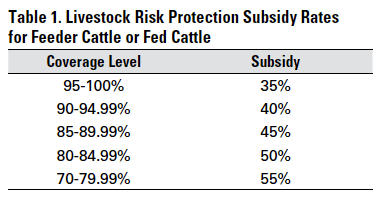Safeguarding Success: Bagley Risk Management Solutions
Wiki Article
Exactly How Livestock Risk Security (LRP) Insurance Coverage Can Safeguard Your Livestock Financial Investment
Livestock Danger Defense (LRP) insurance coverage stands as a reputable shield versus the unpredictable nature of the market, supplying a calculated strategy to guarding your assets. By diving right into the complexities of LRP insurance policy and its complex advantages, animals producers can strengthen their investments with a layer of safety that goes beyond market fluctuations.
Recognizing Animals Danger Defense (LRP) Insurance Policy
Recognizing Livestock Danger Protection (LRP) Insurance is necessary for animals producers aiming to mitigate financial threats associated with price variations. LRP is a government subsidized insurance coverage item created to protect manufacturers against a decrease in market value. By offering insurance coverage for market value declines, LRP helps manufacturers lock in a flooring rate for their animals, guaranteeing a minimum degree of earnings despite market variations.One secret facet of LRP is its adaptability, allowing producers to personalize protection degrees and plan sizes to match their details needs. Manufacturers can select the variety of head, weight array, insurance coverage price, and coverage duration that align with their manufacturing objectives and risk resistance. Understanding these personalized alternatives is essential for manufacturers to properly manage their price danger exposure.
Moreover, LRP is available for various animals kinds, consisting of cattle, swine, and lamb, making it a flexible risk administration device for animals producers across various sectors. Bagley Risk Management. By acquainting themselves with the intricacies of LRP, manufacturers can make educated choices to secure their financial investments and make sure financial stability when faced with market unpredictabilities
Advantages of LRP Insurance Policy for Livestock Producers
Animals producers leveraging Animals Threat Protection (LRP) Insurance coverage get a tactical advantage in shielding their investments from price volatility and protecting a stable financial footing in the middle of market uncertainties. By establishing a floor on the cost of their animals, producers can mitigate the threat of substantial economic losses in the occasion of market slumps.
In Addition, LRP Insurance policy gives manufacturers with tranquility of mind. On the whole, the advantages of LRP Insurance policy for animals manufacturers are significant, using a useful device for handling danger and making sure economic protection in an uncertain market environment.
How LRP Insurance Policy Mitigates Market Risks
Mitigating market dangers, Animals Threat Defense (LRP) Insurance coverage offers livestock producers with a trusted guard versus cost volatility and financial unpredictabilities. By using protection versus unforeseen price declines, LRP Insurance coverage helps manufacturers protect their financial investments and preserve economic stability despite market changes. This kind of insurance policy enables livestock manufacturers to secure a price for their animals at the start of the policy duration, making sure a minimum cost degree despite market changes.

Steps to Secure Your Animals Financial Investment With LRP
In the world of agricultural danger management, executing Livestock Risk Protection (LRP) Insurance coverage entails a critical process to safeguard investments against market fluctuations and unpredictabilities. To protect your animals investment efficiently with LRP, the initial step is to evaluate the details risks your operation deals with, such as cost volatility or unexpected climate events. Comprehending these dangers enables you to determine the protection level needed to secure your investment properly. Next, it is crucial to study and choose a trusted insurance coverage carrier that uses LRP policies customized to your animals and organization requirements. Very carefully examine the policy terms, conditions, and insurance coverage restrictions to ensure they align with your risk administration goals once you have actually picked Visit This Link a supplier. In addition, regularly keeping an eye on market patterns and changing your protection as needed can aid maximize your defense against potential losses. By complying with these actions vigilantly, you can boost the safety of your livestock financial investment and navigate market uncertainties with confidence.Long-Term Financial Safety And Security With LRP Insurance Policy
Ensuring enduring financial security through the application of Livestock Risk Defense (LRP) Insurance policy is a prudent lasting strategy for farming manufacturers. By including LRP Insurance coverage right into their risk management plans, farmers can secure their livestock financial investments versus unexpected market changes and damaging events that can threaten their economic well-being over time.One key advantage of LRP Insurance policy for lasting economic safety is the comfort it provides. With a trustworthy insurance coverage policy in position, farmers can minimize the economic dangers linked with unstable market conditions and unexpected losses due to factors such as illness outbreaks or natural disasters - Bagley Risk Management. This stability enables manufacturers to concentrate on the day-to-day operations of their livestock organization without constant concern about prospective financial troubles
Furthermore, LRP Insurance policy provides an organized method to managing threat over the long term. By setting particular protection levels and choosing proper recommendation periods, farmers can customize their insurance coverage intends to align with their financial goals and take the chance of resistance, making certain a sustainable and safe and secure future for their livestock operations. Finally, purchasing LRP Insurance is a positive approach for agricultural producers to achieve long-term financial safety and secure their resources.
Conclusion
To conclude, Livestock Threat Defense (LRP) Insurance coverage is a beneficial device for livestock producers to minimize market risks and safeguard their investments. By recognizing the advantages of LRP insurance coverage and taking actions to apply it, producers can accomplish long-lasting monetary security for their operations. LRP insurance policy offers a safety and security net versus rate variations and guarantees a level of security in an unpredictable market atmosphere. It is a smart choice for securing livestock investments.
Report this wiki page